
views
- To have ChatGPT write an essay, tell it your topic, word count, type of essay, and facts or viewpoints to include.
- ChatGPT is also useful for generating essay topics, writing outlines, and checking grammar.
- Because ChatGPT can make mistakes and trigger AI-detection alarms, it's better to use AI to assist with writing than have it do the writing.
Getting ChatGPT to Write the Essay
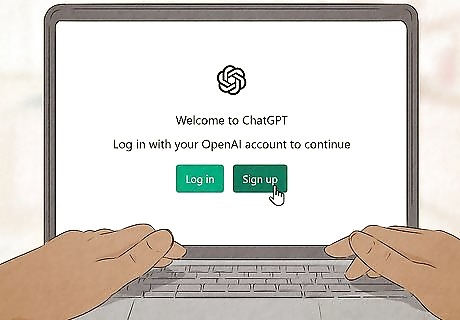
Create an account with ChatGPT. If you're new to OpenAI's chatbot ChatGPT, you'll need to set up an account to get started. Go to https://chat.openai.com/chat, click Sign up, and follow the on-screen instructions to create your account. Before using the OpenAI's ChatGPT to write your essay, make sure you understand your instructor's policies on AI tools. Using ChatGPT may be against the rules, and it's easy for instructors to detect AI-written essays. While you can use ChatGPT to write a polished-looking essay, there are drawbacks. Most importantly, ChatGPT cannot verify facts or provide references. This means that essays created by ChatGPT may contain made-up facts and biased content. It's best to use ChatGPT for inspiration and examples instead of having it write the essay for you.
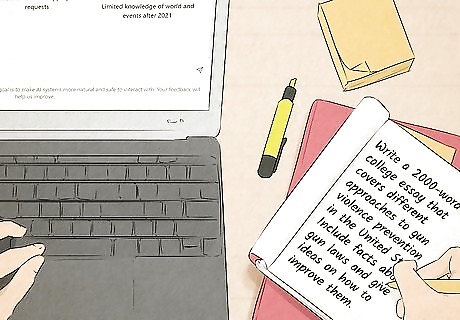
Gather your notes. The best way to get ChatGPT to write an essay is to provide it with as much information about your essay requirements as possible. Make sure you have: The topic you want to write about. Essay length, such as word or page count. Whether you're writing an essay for a class, college application, or even a cover letter, you'll want to tell ChatGPT how much to write. Other assignment details, such as type of essay (e.g., personal, book report, etc.) and points to mention. If you're writing an argumentative or persuasive essay, know the stance you want to take so ChatGPT can argue your point. If you have notes on the topic that you want to include, you can also provide those to ChatGPT. When you plan an essay, think of a thesis, a topic sentence, a body paragraph, and the examples you expect to present in each paragraph. It can be like an outline and not an extensive sentence-by-sentence structure. It should be a good overview of how the points relate.
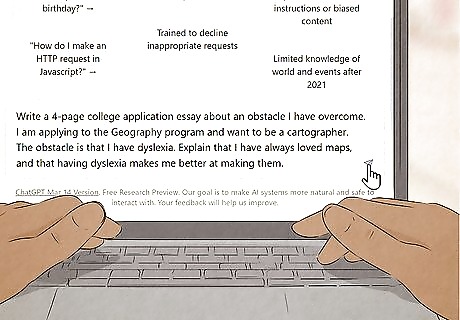
Ask ChatGPT to write the essay. To get the best essay from ChatGPT, create a prompt that contains the topic, type of essay, and the other details you've gathered. In these examples, we'll show you prompts to get ChatGPT to write an essay based on your topic, length requirements, and a few specific requests: "Write a 2000-word college essay that covers different approaches to gun violence prevention in the United States. Include facts about gun laws and give ideas on how to improve them." "Write a 4-page personal high school essay about the Israel Palestine conflict, showing that I feel conflicted and want a peaceful solution." This prompt not only tells ChatGPT the topic, length, and grade level, but also that the essay is personal. ChatGPT will write the essay in the first-person point of view. "Write a 4-page college application essay about an obstacle I have overcome. I am applying to the Geography program and want to be a cartographer. The obstacle is that I have dyslexia. Explain that I have always loved maps, and that having dyslexia makes me better at making them."

Add to or change the essay. While ChatGPT can provide a complete essay with a simple prompt, it may not include everything you need. Fortunately, you can add additional information or remove parts by continuing the conversation with the chat bot. Just tell ChatGPT what you want to change, and it will produce an updated version of the same essay. For example: In our essay about gun control, ChatGPT did not mention school shootings. If we want to discuss this topic in the essay, we can use the prompt, "Discuss school shootings in the essay." Let's say we review our college entrance essay and realize that we forgot to mention that we grew up without parents. Add to the essay by saying, "Mention that my parents died when I was young." In the Israel-Palestine essay, ChatGPT explored two options for peace: A 2-state solution and a bi-state solution. If you'd rather the essay focus on a single option, ask ChatGPT to remove one. For example, "Change my essay so that it focuses on a bi-state solution."
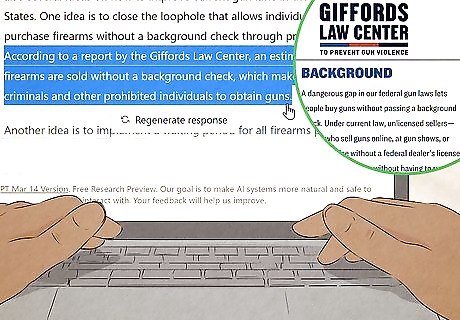
Ask for sources. Because ChatGPT won't provide citations in the essay, ask for sources separately. ChatGPT can't tell you where the sources were used in the essay it wrote for you, and there's also no way to confirm the bot even used those sources. However, you can go through the list of sources to add your own citations later.

Read and edit your essay. Even though the essay may look great on the surface, ChatGPT cannot verify facts. It also may include sentences that don't make much sense in context. Read the essay thoroughly, check the facts, and verify with legitimate sources.
Using AI to Help You Write
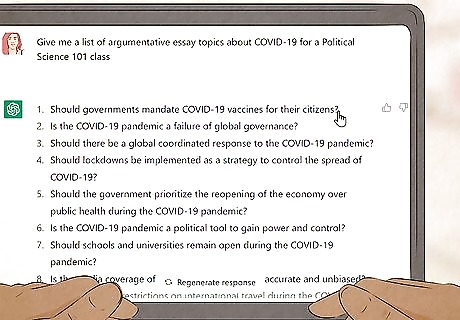
Generate essay topics. If you're not sure what to write about, ask ChatGPT for ideas. Give the bot some details about the type of essay you have to write, such as the type of essay and general subject area. ChatGPT will respond with a list of topic ideas, along with suggestions on how you might frame your essay. You can even just copy and paste your instructor's essay requirements into the bot and say "Help me come up with an idea for this assignment." Here are a few example prompts to try: "Give me ideas for an essay about the Israel-Palestine conflict." "Ideas for a persuasive essay about a current event." "Give me a list of argumentative essay topics about COVID-19 for a Political Science 101 class."
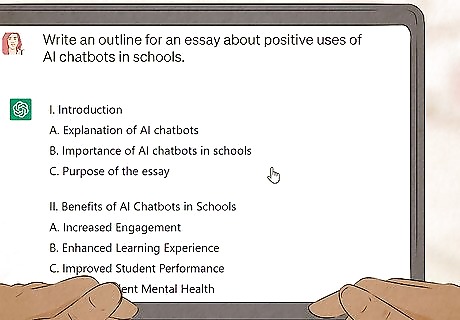
Create an outline. Once you have a topic in mind, ask ChatGPT to generate an outline for your essay. ChatGPT will supply the structure for your essay, which is often the hardest part about writing a paper. Try these prompts to get started: "Create an outline for an argumentative essay called "The Impact of COVID-19 on the Economy." "Write an outline for an essay about positive uses of AI chatbots in schools." "Create an outline for a short 2-page essay on disinformation in the 2016 election."
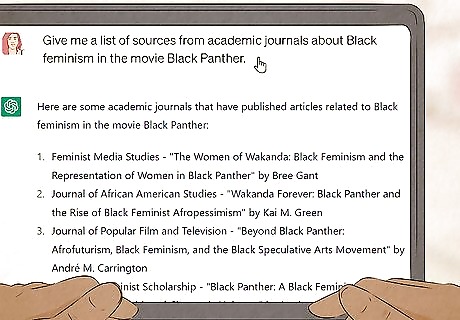
Find sources. If you're having trouble finding legitimate sources to use in your essay, ask ChatGPT to help. Write, "Find sources for my paper

Create a sample essay. It can be helpful to see an example essay written by ChatGPT before you start writing. Don't be tempted to copy ChatGPT's work—instructors often use AI-detection tools that will flag your essay as AI-written or plagiarized. Instead, ask ChatGPT to write an essay using the information you've gathered from the bot, and use it as a guide for your own essay writing. Some examples: "Write a 4-page college paper about how global warming is changing the automotive industry in the United States." "Write a 750-word personal college entrance essay about how my experience with homelessness as a child has made me more resilient." You can even refer to the outline you created with ChatGPT, as the AI bot can reference up to 3000 words from the current conversation. For example: "Write a 1000 word argumentative essay called 'The Impact of COVID-19 on the United States Economy' using the outline you provided. Argue that the government should take more action to support businesses affected by the pandemic."
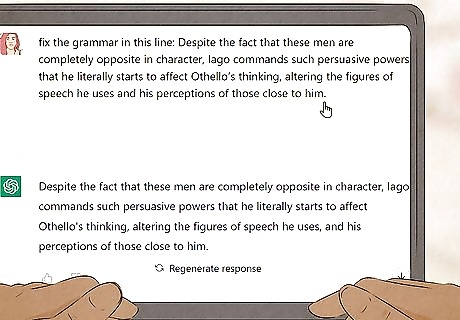
Use ChatGPT to proofread and tighten grammar. ChatGPT can check your work for errors and make corrections as needed. You can even give instructions like "fix passive language in my essay" before pasting the contents of the essay into the field.
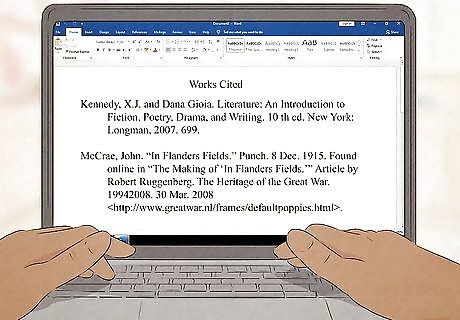
Generate a Works Cited page or bibliography. It can be tough to remember the requirements for listing references in MLA, APA, and other formats. Fortunately, ChatGPT can take the pain out of citations by transforming your references into a teacher-approved bibliography. One way to do this is to paste a list of the sources you've used, including URLs, book titles, authors, pages, publishers, and other details, into ChatGPT along with the instruction "Create an MLA Works Cited page for these sources." You can also ask ChatGPT to provide a list of sources, and then build a Works Cited or References page that includes those sources. You can then replace sources you didn't use with the sources you did use.



















Comments
0 comment